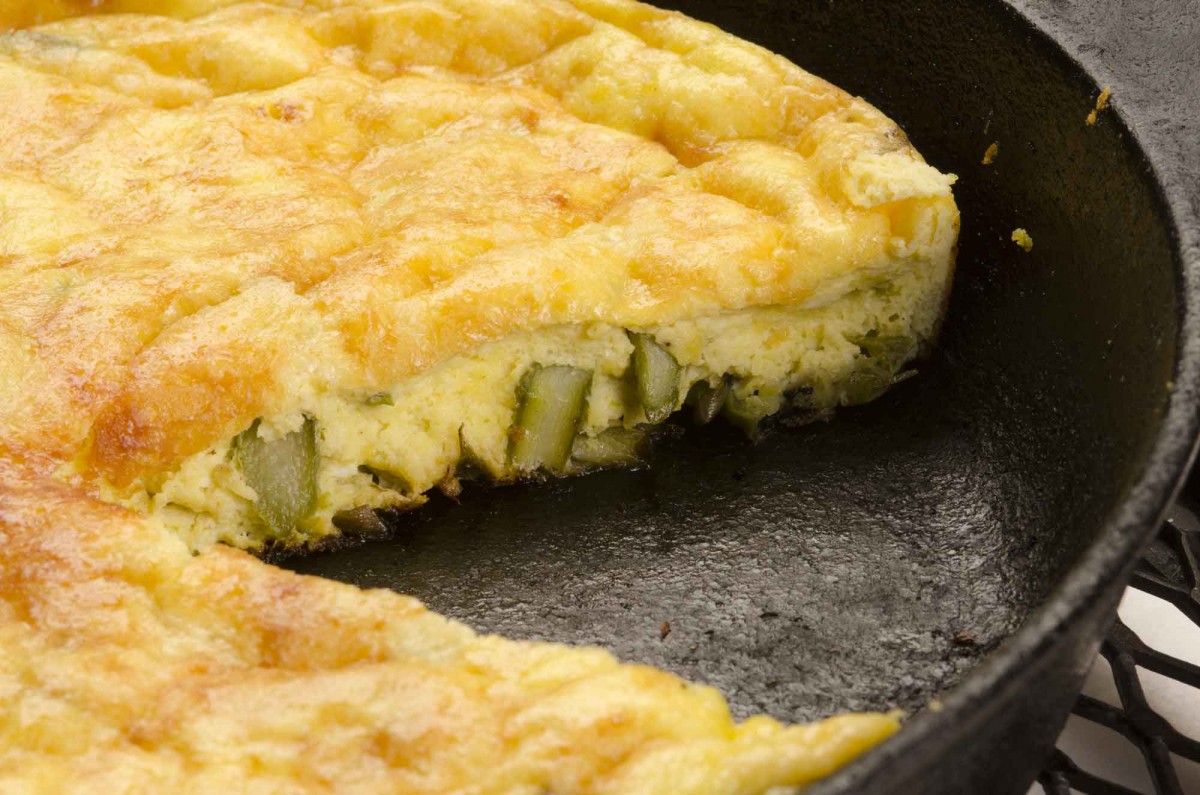Watch the Video Here
In today’s video, I present a dish that embodies the essence of spring simplicity. This recipe for a Mediterranean Asparagus-Ricotta Frittata is from the Spring chapter of our book Cooking with the Muse. The magic ingredient is the ricotta, which lends an extraordinarily light and fluffy quality to the eggs. After being transferred from the sizzling skillet to the oven, the frittata is then delivered, in its green and golden glory, to your plate. It’s made in one pan, and you need only one bowl, so the cleanup time for such a guest-worthy main course is minimal. Best of all, it’s truly delicious.
Start with a pound of asparagus, cut diagonally into small pieces. Place the cut pieces in a 10-inch cast iron skillet or non-stick skillet, along with a knob of butter, a couple tablespoons of water, and a sprinkling of salt. Cover the pan and set over medium heat for a few minutes to give the asparagus a head start. The little bit of added water will help the pieces steam. After a minute, stir to help the butter melt; cook for about 3 to 4 minutes, until the asparagus pieces are just tender. Uncover—you’ll notice the water has evaporated—and sauté for another minute or so to brown.
Meanwhile, in a medium bowl, whisk together 6 eggs, 1 cup ricotta cheese, 1/2 teaspoon salt, and a generous sprinkling of black pepper. Now, if you like, add some fresh herbs—any delicate herb that complements asparagus. In the video, I use a mix of oniony chives and anise-like tarragon. Other options include feathery chervil, lemony sorrel, or even parsley. Besides brightening dishes to which they are added, a mix of fresh herbs has a whole array of healing properties; each herb lends its own virtues to a tidy and flavorful package. Chives, for instance, have anti-inflammatory properties, and tarragon is known to have antioxidant properties. That is just the beginning of a long list.
Next, pour the egg mixture over the asparagus, letting it completely cover the asparagus. Let it cook for about 5 minutes, just until the eggs have started to set and the frittata has started to color around the edges. A non-stick skillet is appropriate, although nothing beats the glorious amber frittata you can cook up in a cast iron skillet. Now that the frittata has set just a little, sprinkle about 1/2 cup of grated Parmesan evenly over the top. Next, place the whole skillet in a preheated 300 degree oven. The frittata takes about 15 to 20 minutes to cook, during which time your kitchen will smell delightful. Set the pan under the broiler the last couple of minutes in order to get a golden, puffed, pillowy top. One word of caution: When you take a hot skillet out of the oven, set a towel or mitt over the handle—anything to remind you that the handle is hot! You’ll know this intellectually, but force of habit is strong, and it’s easy to inadvertently grab a hot handle of a skillet that you have just removed from the oven, so be careful. Next, slide the frittata out of the skillet onto a plate or a cutting board, and divide it into portions.
If you don’t eat all of the frittata in one sitting, this particular dish (unlike many egg dishes) can be refrigerated for up to a few days and then reheated. Enjoy this scrumptious egg-stravaganza for a quick meal anytime.
